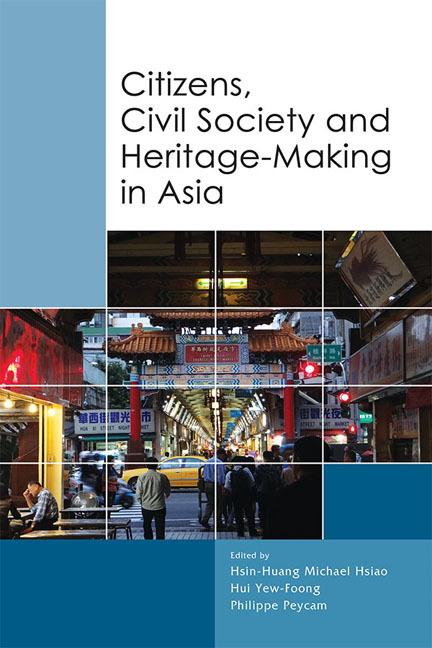Book contents
- Frontmatter
- Contents
- Contributors
- 1 Introduction: Finding the Grain of Heritage Politics
- 2 Heritage, Identity and Power
- 3 Heritage-Making and Post-coloniality in Yangon, Myanmar
- 4 Living Heritage of Ruins? Contesting the Paradox in Trowulan's Majapahit Heritage
- 5 The Reconstruction of Heritage in Rural Vietnam: An Analysis of State and Local Dynamics
- 6 Performing Cultures, Negotiating Identities: The Cultural Politics of Indigenous Cultural Villages in West Malaysia
- 7 Constituting Philippine Filmic and Linguistic Heritage: The Case of Filipino Regional Films
- 8 Encounter and Counter-Narratives of Heritage in Macau
- 9 Cultural Activities of the Chinese Community in Post-war Myanmar
- 10 Chinese Street Opera in Singapore: Heritage or a Vanishing Trade
- 11 Policy Formation and Civil Society Engagement in Heritage-Making in Taiwan: A Historical Examination
- 12 Becoming Taiwanese: Appropriation of Japanese Colonial Sites and Structures in Cultural Heritage-Making — A Case Study on the Wushantou Reservoir and Hatta Yoichi
- 13 Defining Culture in the Heritage Preservation of Taiwanese Veterans’ Villages: The Case of Zuoying
- 14 Tobacco Crop Memories in Taiwan: The Heritage of a Deadly Agriculture
- Index
13 - Defining Culture in the Heritage Preservation of Taiwanese Veterans’ Villages: The Case of Zuoying
Published online by Cambridge University Press: 03 January 2018
- Frontmatter
- Contents
- Contributors
- 1 Introduction: Finding the Grain of Heritage Politics
- 2 Heritage, Identity and Power
- 3 Heritage-Making and Post-coloniality in Yangon, Myanmar
- 4 Living Heritage of Ruins? Contesting the Paradox in Trowulan's Majapahit Heritage
- 5 The Reconstruction of Heritage in Rural Vietnam: An Analysis of State and Local Dynamics
- 6 Performing Cultures, Negotiating Identities: The Cultural Politics of Indigenous Cultural Villages in West Malaysia
- 7 Constituting Philippine Filmic and Linguistic Heritage: The Case of Filipino Regional Films
- 8 Encounter and Counter-Narratives of Heritage in Macau
- 9 Cultural Activities of the Chinese Community in Post-war Myanmar
- 10 Chinese Street Opera in Singapore: Heritage or a Vanishing Trade
- 11 Policy Formation and Civil Society Engagement in Heritage-Making in Taiwan: A Historical Examination
- 12 Becoming Taiwanese: Appropriation of Japanese Colonial Sites and Structures in Cultural Heritage-Making — A Case Study on the Wushantou Reservoir and Hatta Yoichi
- 13 Defining Culture in the Heritage Preservation of Taiwanese Veterans’ Villages: The Case of Zuoying
- 14 Tobacco Crop Memories in Taiwan: The Heritage of a Deadly Agriculture
- Index
Summary
Introduction: The Origin of Taiwanese Veterans’ Villages
After the Chinese civil war spread in February 1947, the troops of the Chinese Nationalist Party (KMT) suffered successive military reversals in the Liaoshen, Pingjin and Huaihai campaigns of 1948. Consequently, the KMT military strategy was to retreat.1 At a military conference in Dinghai in 1949, from among the three possible strategies — “shift to Xikang”, “retreat to Hainan Island” or “retreat to Taiwan” — Chiang Kaishek elected for the Taiwan option.2 The retreat to Taiwan in 1949 saw the transportation of governmental agencies and large quantities of antiques to Taiwan. According to statistics, 1.2 million troops and civilians were moved between 1945 and 1953 (Lin 2011, p. 250).
To relocate millions of KMT soldiers and their dependents, Taiwanese veterans’ villages (pinyin: juancun) gradually emerged on the landscape of Taiwan. According to Guo Guanlin, it is not correct to see the Taiwanese veterans’ villages as “villages built up for the soldiers and dependents”, because the villages were constructed with the exclusive political motive “to stabilize the morale of the KMT troops” (Guo 2005, p. 1). Early in 1932, military settlements similar to the Taiwanese veterans’ villages emerged in Jiangxi Province and Shanxi Province of mainland China. These settlements were built to accommodate KMT troops and to support the fight against the Communist forces. Prior to 1949 the military settlements in Taiwan were mostly quarters and barracks left by the Japanese colonial power. For instance, Whampoa New Village in Fengshan District of Kaohsiung City is typically regarded as the earliest dormitory for Japanese land forces. Gu Chaoguang proposed that due to dissatisfaction with the KMT's internal conflict between the Whampoa warlords and the Baoding warlords, Sun Liren arrived at Fengshan for troop training in October 1947. He established the fourth military training class and arranged the accommodation for soldiers and their dependents in Whampoa New Village. As the civil war in mainland China worsened during the retreat, temporary buildings, rebuilt warehouses, old factories, and even illegal houses were gradually subsumed within the category of Taiwanese veterans’ villages.
- Type
- Chapter
- Information
- Citizens, Civil Society and Heritage-Making in Asia , pp. 281 - 304Publisher: ISEAS–Yusof Ishak InstitutePrint publication year: 2017

